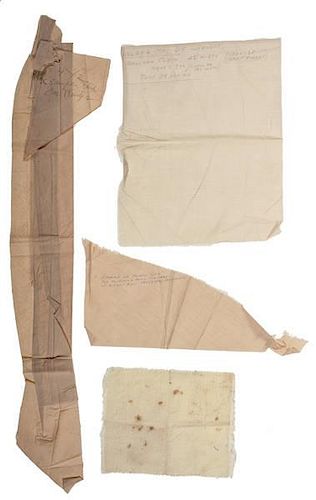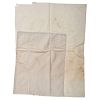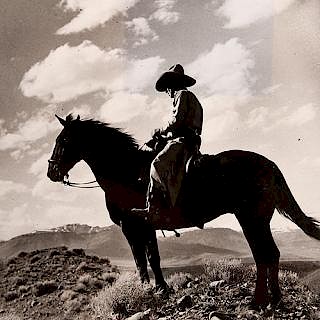Wright Brothers, Collection of Cloth Samples Considered for the Reconstruction of the Wright 1905 Flyer, Carillon Park, Dayton, OH
About Seller
6270 Este Ave.
Cincinnati , OH 45232
United States
With offices in Cincinnati, Cleveland and Denver, Cowan’s holds over 40 auctions each year, with annual sales exceeding $16M. We reach buyers around the globe, and take pride in our reputation for integrity, customer service and great results. A full-service house, Cowan’s Auctions specializes in Am...Read more
Two ways to bid:
- Leave a max absentee bid and the platform will bid on your behalf up to your maximum bid during the live auction.
- Bid live during the auction and your bids will be submitted real-time to the auctioneer.
Bid Increments
| Price | Bid Increment |
|---|---|
| $0 | $25 |
| $500 | $50 |
| $1,000 | $100 |
| $2,000 | $250 |
| $5,000 | $500 |
| $10,000 | $1,000 |
| $20,000 | $2,500 |
| $50,000 | $5,000 |
| $100,000 | $10,000 |
About Auction
Jun 12, 2015 - Jun 13, 2015
Cowan's Auctions dawnie@cowans.com
- Lot Description
Lot of 12 cloth samples that were considered for covering the reconstruction of the 1905 Wright Flyer, ranging in size from 6 x 6.5 in. to 28 x 41.5 in.
The original fabric used on the 1903 Flyer was called the "Pride of the West," which was unbleached muslin that was also used on the 1904 and 1905 Flyers. The warp and woof was approximately 108 (threads per inch).
In 1925, the "Pride of the West" was still made available by American Bleached Goods Co., NY, and the fabric was used on the reconstruction of the "Kittyhawk" - 1903 Flyer for the Science Museum of South Kensington, England. After 1928, the "Pride of the West" was no longer available.
The fabric included in this lot has been identified as "Aeroplane Fabric," with a warp of 80 and woof of 84. This fabric, which was called "Pride of America" - #413,199, was made at 42 in. width with a weight of 3.4 oz per lineal yd. by Riverside and Dan River Cotton Mills, Inc., Danville, VA. This was purchased through Inland Manufacturing (Dayton, OH) - from Wellington - Sears - Chicago, IL.
The samples in the lot include the following highlights, as identified through the notes of Louis P. Christman and the consignor:
10 "Pride of America," unbleached muslin samples that were used to cover the wings during the reconstruction of the 1905 Wright Flyer, including a Sample of wing fabric used for covering wing surface of Wright Brothers 1905 (3rd) Aeroplane, as written on fabric, 7 x 15 in.; a "sample strip" for a wing rib to fit into, which acts as a support and attaches to the fabric wing surface, 4.5 x 32 in.; a piece of shop cloth used as a shop rag in the reconstruction, 7.75 x 22.5 in. Very little was thrown away, and rags such as this were kept as part of the aesthetics of the rebuild; and a swatch that has been stitched to allow a wing rib to run through it. This was a pocket that ran the width of the wing, 14.5 x 20 in.
The lot also features a balloon cloth sample, 11 x 13 in., with a warp of 130 and woof of 138, which was considered due to the weight factor, but was considered too far from the original warp and woof of the 1903 Flyer, plus a piece of shop cloth used as a shop rag in the reconstruction, 6.75 x 8.5 in.
Louis P. Christman (1893-1972)
As an employee of National Cash Register, with his experience in aircraft and machine design, Louis P. Christman was called upon by prominent engineer and inventor, Colonel Edward Deeds, to undertake the restoration of the 1905 Wright Flyer, which resides at Carillon Park, Dayton, Ohio. Christman was given the opportunity to work closely with Orville Wright in order to produce an accurate set of drawings, or blueprints, for the 1900, 1901, and 1902 gliders as well as the 1903, 1904, and 1905 Wright Flyers. Since no complete drawings were ever produced by Orville and Wilbur Wright during the building and flying of the planes, it was required that Christman travel to Washington, D.C. to the Smithsonian Institution to take measurements and make drawings from the original 1903 Flyer that is displayed there and to discuss these drawings with Orville Wright.
Continued meetings and conversations between Orville Wright and Christman resulted in a very refined set of drawings of the three planes and their engines – drawings that were quite satisfactory to Orville Wright. Christman, under the direction of Colonel Edward Deeds, then began the restoration of the 1905 Flyer in 1947, on the grounds of the National Cash Register Co. This project involved not only incorporating as many original parts as could be obtained, but the designing and machining of matching parts in order to complete the aeroplane. This restoration project took Christman approximately 19 months, from the drawing stage to the completion of the frame. Final construction and assembly was completed at Carillon Historical Park, where the plane was reassembled and fabric was stretched.
Christman’s drawings are well documented in the Smithsonian Institution’s National Air and Space Museum. Knowledgeable men and women who have produced models and full-sized planes since 1948 have relied most exclusively on the “Christman Drawings.” The Smithsonian Institution has recently produced framed copies of Christman’s three view plate, with consideration in print concerning the works of Christman. The work that Christman did for Orville Wright, Dayton Wright Aeroplane, Charles F. Kettering, Inland Manufacturing, NCR Corp., Colonel Deeds, and Carillon Park is of considerable historical importance and interest.
Lots 284-290 represent a portion of items given to Christman for his work in restoring the 1905 Wright Flyer, and they have descended directly in his family.These are cloth samples, so the sizing is only approximate. The pieces show scattered wear and spotting. Typical folds in fabric. Some fabric includes penciled notes.Condition
- Shipping Info
-
SHIPPING. At the request of the buyer, Cowan's will authorize the shipment of purchased items. Shipments usually occur within two weeks after payment has been received. Shipment is generally made via UPS Ground service. Unless buyer gives special instructions, the shipping method shall be at the sole discretion of Cowan's Auctions, Inc.. Cowan's is in no way responsible for the acts or omissions of independent handlers, packers or shippers of purchased items or for any loss, damage or delay from the packing or shipping of any property.
-
- Buyer's Premium



 EUR
EUR CAD
CAD AUD
AUD GBP
GBP MXN
MXN HKD
HKD CNY
CNY MYR
MYR SEK
SEK SGD
SGD CHF
CHF THB
THB













